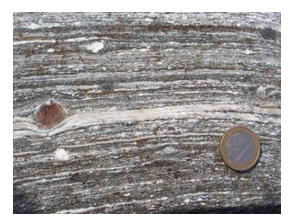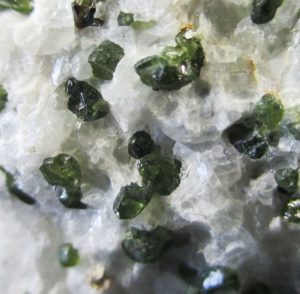4.2.4: Metamorphic Minerals
- Page ID
- 19135

Metamorphism sometimes involves recrystallization and coarsening of a rock with no change in mineralogy. Often, however, it involves chemical reactions and replacement of preexisting minerals by new ones. Bonds are broken and atoms migrate by solid state diffusion or are transported short distances by intergranular fluids to sites where new minerals crystallize and grow. The photo shows a large red garnet crystal in a highly deformed metamorphic rock called a mylonite. Large minerals of this sort in metamorphic rocks are called phenocrysts.
The mineralogy of metamorphic rocks is more diverse than in sedimentary or igneous rocks. Nearly all the minerals found in igneous rocks can be present in metamorphic rocks. Many minerals that are found in sedimentary rocks may be present as well. In addition, other minerals, uncommon or nonexistent in igneous and sedimentary rocks, form through metamorphism. The table below lists only a few of the more common metamorphic minerals.
| Common Metamorphic Minerals (besides those common in igneous and sedimentary rocks) |
|
| mineral | chemical formula |
| cordierite tremolite wollastonite andalusite kyanite sillimanite staurolite chloritoid garnet zoisite |
(Mg,Fe)2Al4Si5O18 Ca2Mg5Si8O22(OH)2 CaSiO3 Al2SiO5 Al2SiO5 Al2SiO5 Fe2Al9Si4O23(OH) (Fe,Mg)Al2SiO5(OH)2 (Ca,Fe,Mg)3(Al,Fe)2Si3O12 Ca2Al3Si3O12(OH) |

Metamorphism may involve replacement of one mineral by another. For example, calcite may become aragonite or vice versa. Both minerals are CaCO3, but their atomic structures differ. Mineralogical changes due to metamorphism, however, usually involve several different minerals reacting together. Dolomite (CaMg(CO3)2) and quartz (SiO2) may react to form diopside (CaMgSi2O6) if a limestone containing quartz is metamorphosed at high temperature. The photo here shows green diopside surrounded by dolomite and calcite.


